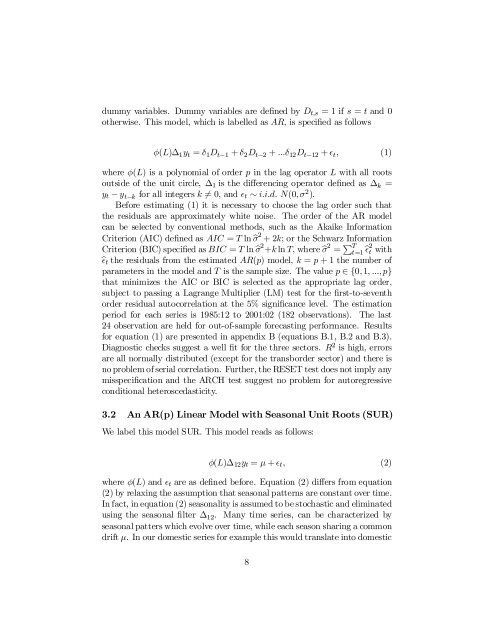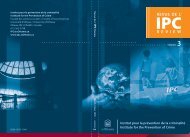0306E - Faculty of Social Sciences - Université d'Ottawa
0306E - Faculty of Social Sciences - Université d'Ottawa
0306E - Faculty of Social Sciences - Université d'Ottawa
You also want an ePaper? Increase the reach of your titles
YUMPU automatically turns print PDFs into web optimized ePapers that Google loves.
dummy variables. Dummy variables are de…ned by D t;s = 1 if s = t and 0<br />
otherwise. This model, which is labelled as AR; is speci…ed as follows<br />
Á(L)¢ 1 y t = ± 1 D t¡1 + ± 2 D t¡2 + :::± 12 D t¡12 + ² t ; (1)<br />
where Á(L) is a polynomial <strong>of</strong> order p in the lag operator L with all roots<br />
outside <strong>of</strong> the unit circle, ¢ 1 is the di¤erencing operator de…ned as ¢ k =<br />
y t ¡ y t¡k for all integers k 6= 0, and ² t » i:i:d: N(0; ¾ 2 ).<br />
Before estimating (1) it is necessary to choose the lag order such that<br />
the residuals are approximately white noise. The order <strong>of</strong> the AR model<br />
can be selected by conventional methods, such as the Akaike Information<br />
Criterion (AIC) de…ned as AIC = T ln b¾ 2 + 2k; or the Schwarz Information<br />
Criterion (BIC) speci…ed as BIC = T ln b¾ 2 +k ln T; where b¾ 2 = P T<br />
t=1 b² 2 t with<br />
b² t the residuals from the estimated AR(p) model, k = p + 1 the number <strong>of</strong><br />
parameters in the model and T is the sample size. The value p 2 f0; 1; :::; pg<br />
that minimizes the AIC or BIC is selected as the appropriate lag order,<br />
subject to passing a Lagrange Multiplier (LM) test for the …rst-to-seventh<br />
order residual autocorrelation at the 5% signi…cance level. The estimation<br />
period for each series is 1985:12 to 2001:02 (182 observations). The last<br />
24 observation are held for out-<strong>of</strong>-sample forecasting performance. Results<br />
for equation (1) are presented in appendix B (equations B.1, B.2 and B.3).<br />
Diagnostic checks suggest a well …t for the three sectors. R 2 is high, errors<br />
are all normally distributed (except for the transborder sector) and there is<br />
no problem <strong>of</strong> serial correlation. Further, the RESET test does not imply any<br />
misspeci…cation and the ARCH test suggest no problem for autoregressive<br />
conditional heteroscedasticity.<br />
3.2 An AR(p) Linear Model with Seasonal Unit Roots (SUR)<br />
We label this model SUR. This model reads as follows:<br />
Á(L)¢ 12 y t = ¹ + ² t , (2)<br />
where Á(L) and ² t are as de…ned before. Equation (2) di¤ers from equation<br />
(2) by relaxing the assumption that seasonal patterns are constant over time.<br />
In fact, in equation (2) seasonality is assumed to be stochastic and eliminated<br />
using the seasonal …lter ¢ 12 . Many time series, can be characterized by<br />
seasonal patters which evolve over time, while each season sharing a common<br />
drift ¹. In our domestic series for example this would translate into domestic<br />
8
















